This week President Joseph Biden stopped at an Illinois farm to say he’s going to help the Ukraine ship 20 million tonnes of wheat and corn out of storage into export, thereby relieving grain shortages in the international markets and lowering bread prices around the world. Biden was trying to play a hand in which his cards have already been clipped. By Biden.
The first Washington-Kiev war plan for eastern Ukraine has already lost about 40% of the Ukrainian wheat fields, 50% of the barley, and all of the grain export ports. Their second war plan to hold the western region defence lines with mobile armour, tanks, and artillery now risks the loss of the corn and rapeseed crop as well as the export route for trucks to Romania and Moldova. What will be saved in western Ukraine will be unable to grow enough to feed its own people. They will be forced to import U.S. wheat, as well as U.S. guns and the money to pay for both.
Biden told his audience that on the Delaware farms he used to represent in the U.S. Senate “there are more chickens than there are Americans.” Blaming the Russians is the other card Biden has left.
Five maps published by the U.S. Department of Agriculture (USDA) display the location of the main Ukrainian grain and oilseed crops–wheat, corn, barley, sunflower, rapeseed–for the period 2016 to 2020. The percentage of the total crop contributed by each region as a five-year average is also displayed. As of 2020, the leading Ukrainian exports were sunflower and rapeseed oils ($5.32 billion), corn ($4.89 billion), and wheat ($4.61 billion), followed by iron ore ($4.27 billion) and semi-finished iron ($3.03 billion). These last two are entirely concentrated in the east–Dniepropetrovsk, Zaporozhye, and the Donbass.

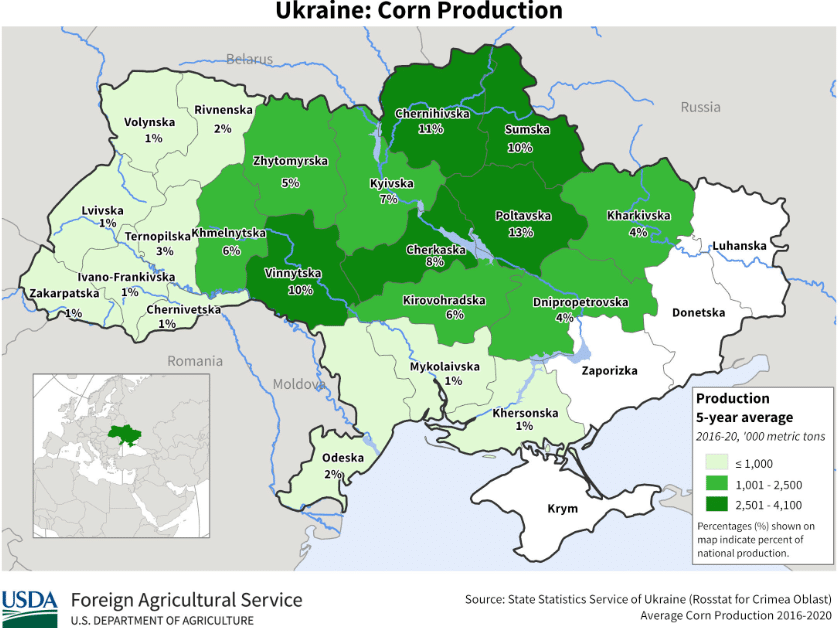
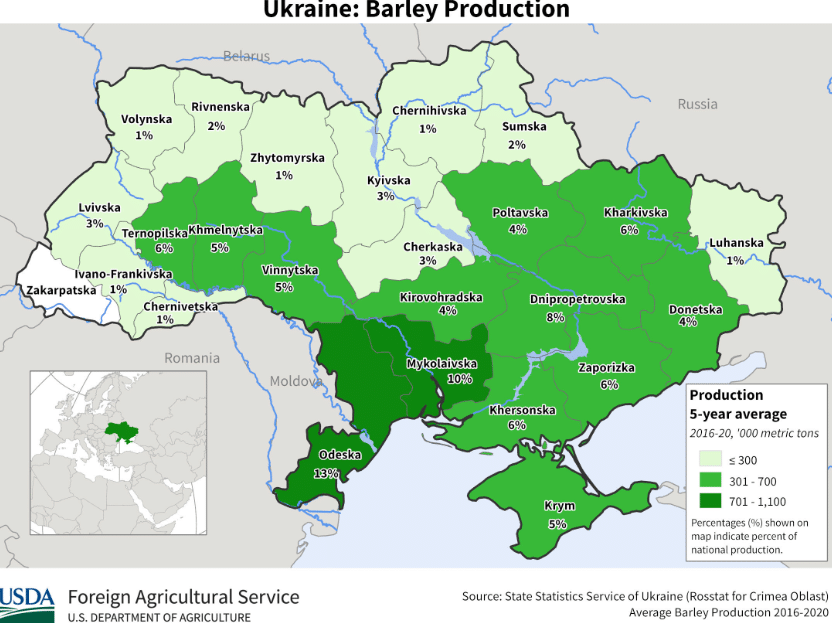
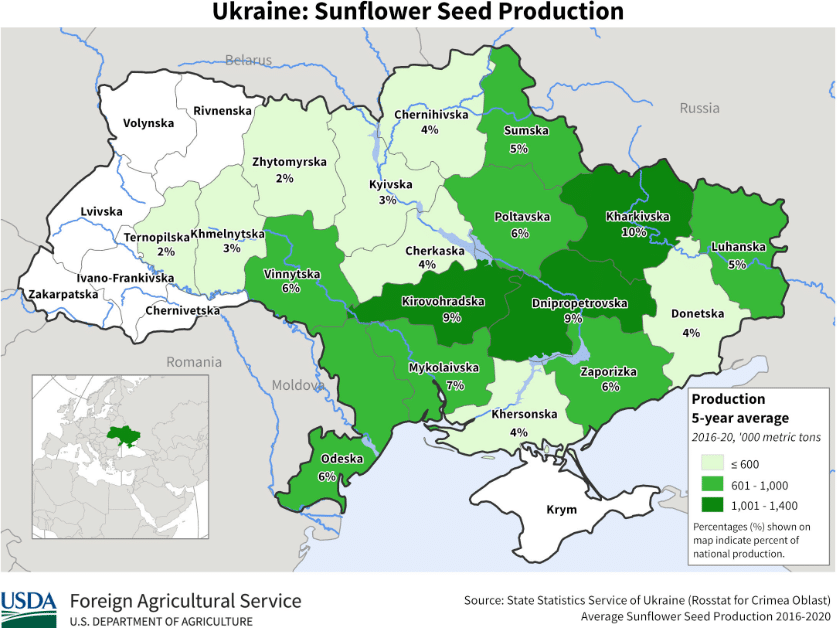
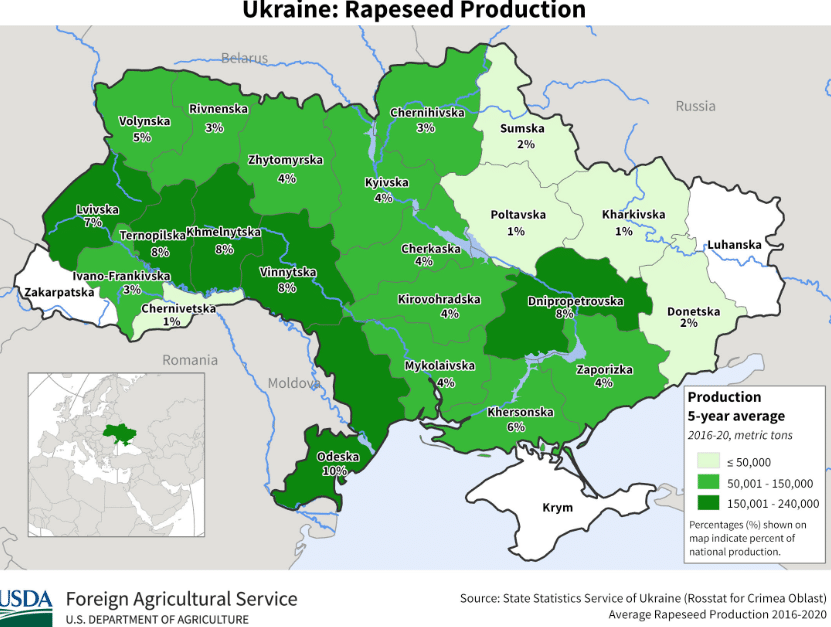
Source: https://ipad.fas.usda.gov
For viewing enlarged images, right click on image and click on new tab.
Just how cut off and dependent on imports the western region of the Ukraine is already, here are maps of the country’s main sources of energy and fuel:
UKRAINE’S OIL, GAS AND COAL
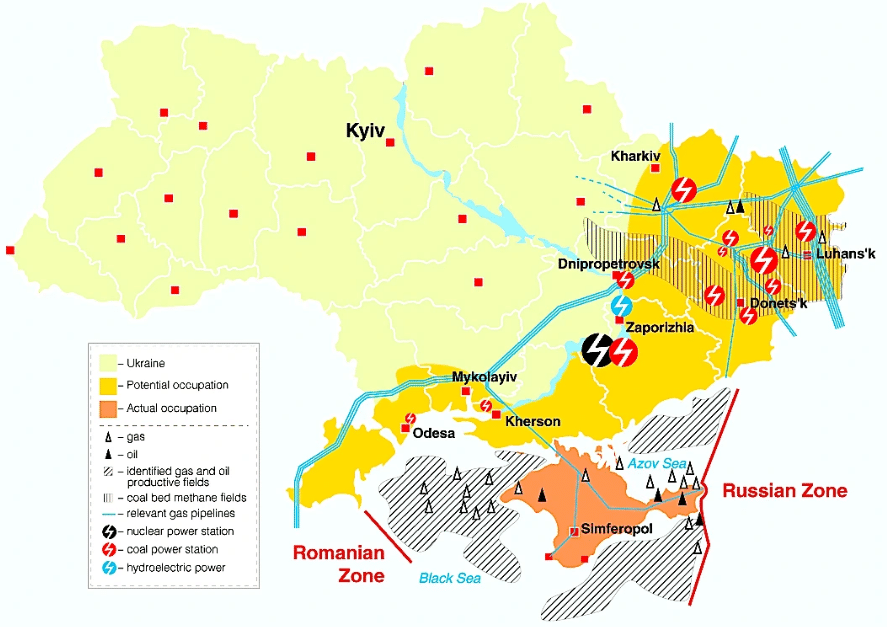
Source: https://geoawesomeness.com/
For the figures for each energy source, see the U.S. Energy Information Administration summary: https://www.eia.gov/
UKRAINE’S NUCLEAR POWER CENTRES

Source: https://www.nsenergybusiness.com/
A report just published in Vzglyad, the best of the Moscow news analyses in publication, spells out the Russian assessment of the impact of war and U.S. sanctions on the Ukraine’s position in the grain markets. The reporter is Nikolai Storozhenko; read the original here. A verbatim translation follows between opening and closing quotes; illustrations, captions, links, and sources have been added to amplify the Russian text.
“HOW THE U.S. CREATED THE GLOBAL FOOD CRISIS
Grain is the key export commodity of Ukraine today
By Nikolai Storozhenko
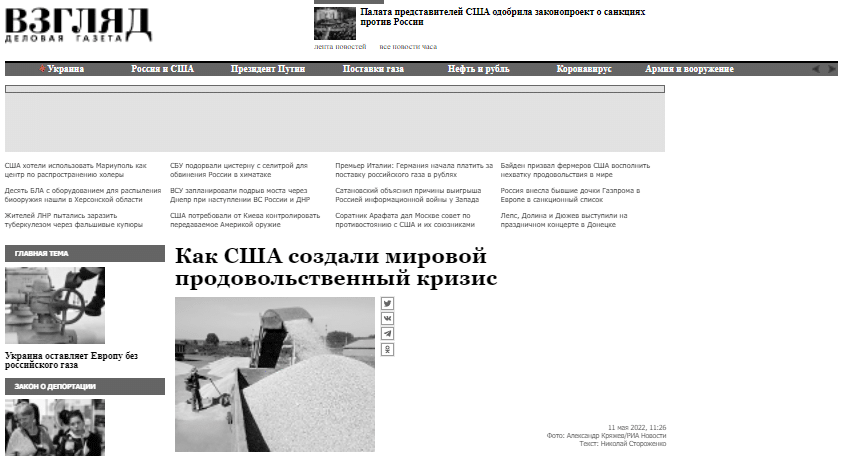
Tens of millions of tons of Ukrainian grain are the most important condition for reducing world food prices–at least this is what U.S. President Joe Biden assures everyone. In addition, Biden blames Russia for the price increase.
There is indeed a commotion on the world grain market, but who is really to blame for this?
‘Ukraine has 20 million tons of grain in its storages. We are studying ways to return this grain to the world market and thereby achieve lower prices,’ is Joe Biden’s simple strategy to curb inflation. Moreover, it relies on an even more fail-safe technique known as blame Russia: ‘We noticed that fuel prices rose in March, it’s because of Putin. Because of him, food prices have also risen in our country.’
Putin was not spared
However, we will correct Mr Biden–firstly, it’s not ‘here’ in the USA, but all over the world except for those countries and regions that promptly imposed restrictions on grain exports. Secondly, the U.S. and its blame-Russia campaign have allowed time for the U.S. to trade its own grain. In the 2021/22 marketing year, the United States exported 18.9 million tons of grain (data at the end of March). On the one hand, this is the lowest figure in the last twenty years. On the other hand, if the Americans are still trading, it means that everything is not as bad as they claim.
Something else is interesting. One of the peaks of world grain prices occurred in the early 1970s. Then the USSR began to buy large quantities of grain in the U.S. and Canada, thereby inflating global prices. Since then and until recently, the United States has remained the largest player in the global grain export market (95 million tons in 2021/22).
If we take wheat separately, then back in 2014 the U.S. also ranked first (25.6 million tons). But Russia’s wheat exports were not so rosy: 1.6 million tons in 2001, a jump to 10 million in 2002, down again, up again. In general, we reached stable volumes only by the end of the 2010s, and comparable to the U.S.–in the same 2014 (22.1 million tons, third place). If you know this, it’s hard to believe that for several years in a row, not the U.S., but Russia has been ranked first in the world in wheat exports (39.5 million tons in 2020/2021).
GLOBAL WHEAT PRODUCTION, 2010-2022
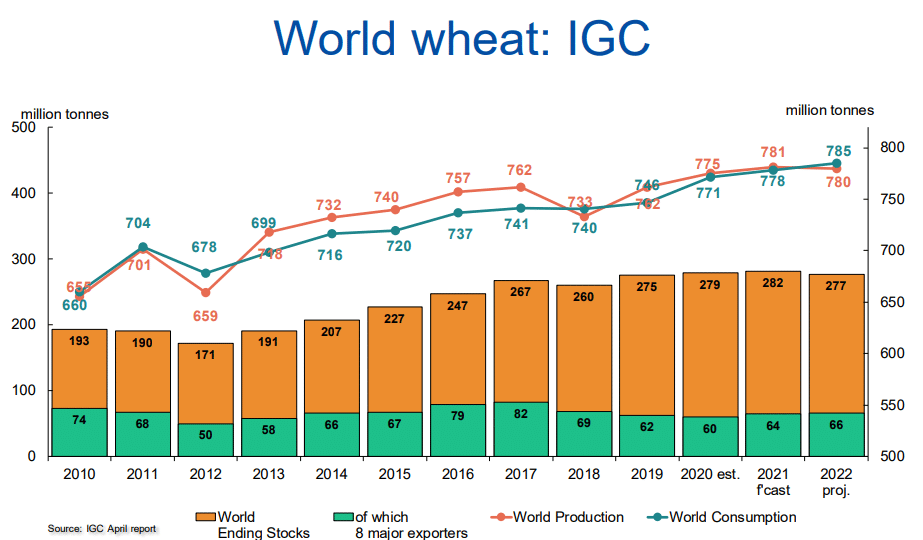
Source: International Grain Council (IGC) data reported by the European Commission. Note that supply has fallen short of consumption three times–in 2012, 2018, and this year. As the following wheat price chart shows, when that happens the price of wheat rises sharply.
TRAJECTORY OF THE GLOBAL WHEAT PRICE, 2000-2021
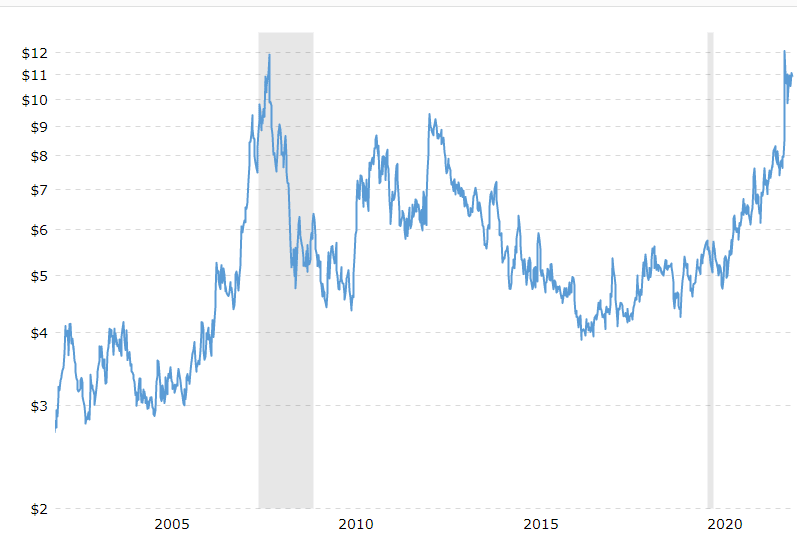
Average closing pricing, in $000–source: https://www.macrotrends.net/
So in some ways Biden is indeed correct: the problem clearly could not have materialised without Putin. But how did it happen that the U.S. moved from the first place in the world in wheat exports to the fourth? And why are the Americans now looking for opportunities to unblock exports from Ukraine to reduce domestic U.S. food prices?
To start with, Biden should blame his predecessor [Donald Trump], who in 2015 launched a large-scale trade war with China. One of the reasons for the war was the long-standing trade balance problem: the U.S. bought and continues to buy more from China than it sells to China. And not just a little more. In 2021, this ‘more’ amounted to a gigantic sum–almost $400 billion. The pandemic played a role here also. But the fact remains that Trump’s tariff war did not correct the situation with the trade balance.
But for American farmers the consequences of this war were very sad. China has shown that it also knows how to fight, and so it raised duties on imports of American wheat. As a result, already in 2018, the Wall Street Journal was writing with chagrin that Russia had not only regained its primacy in the world grain market for the first time in one hundred years, but it was also successfully competing with American wheat in traditionally American markets.
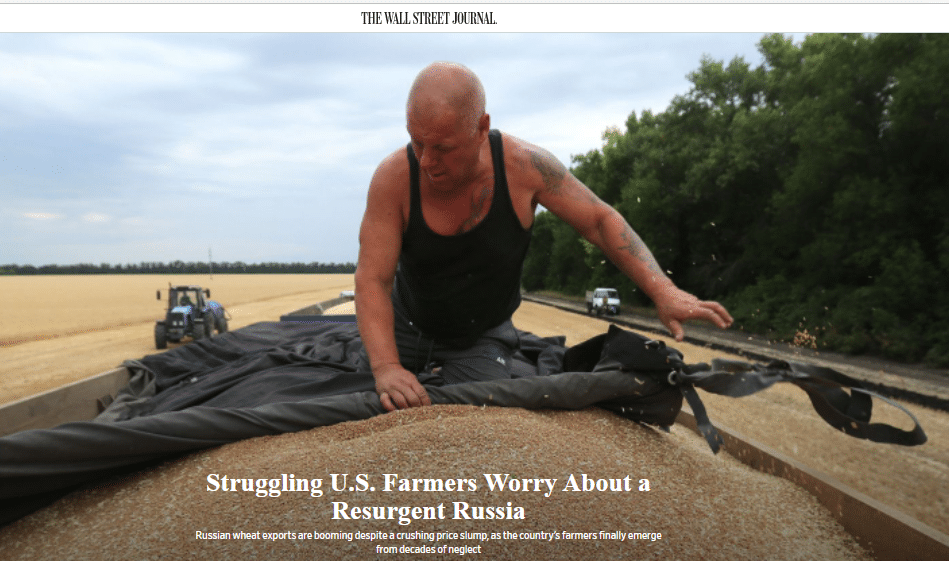
Source: https://www.wsj.com/
Global control
However, the U.S. has long been a player for global stakes that are larger than wheat. To the Wall Street Journal and U.S. farmers, of course, that’s a shame, and American prestige suffers. But why fill up the world and your own market with grain, if there are satellite producers you can employ? Control of the food market as a whole is much more important to the U.S. than revenue from grain exports.
Moreover, everything has been calculated as a whole. The U.S. Department of Agriculture [USDA] publishes crop forecasts by country at the beginning of the calendar year (by the way, these are quite accurate). And the USDA even publishes forecasts of world trade in this wheat market even for several years ahead. Knowing the expected harvest and the projected volume of trade (and therefore the approximate prices), it is possible to manage the commodity cost and food price inflation in the domestic market, and make more efficient the use of America’s own acreage. Why grow millions of tons of corn or feed wheat if the Ukraine sows and grows it?
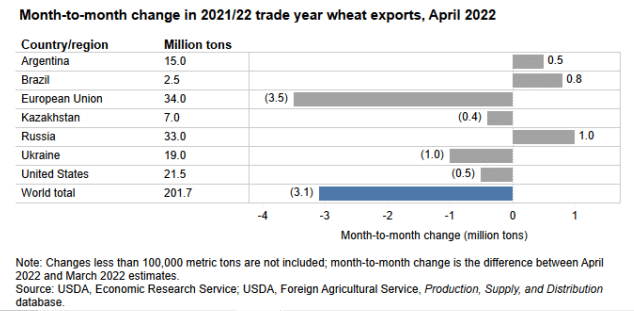
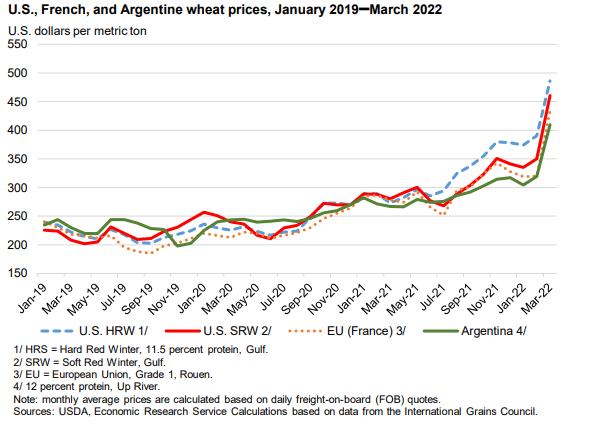
Differences between the grain exports of Ukraine and Russia
The role of the Ukraine here is really difficult to overestimate. Today in publications about the global food crisis, the Ukraine and Russia are constantly placed side by side. They are spoken of as large producers with a large share of the export market of wheat, corn, vegetable oils, etc. Yes, both the Ukraine and Russia sell a lot of food to the foreign market. And yet they display fundamentally different models of agriculture and agricultural exports.
If we take grains, then Russia mainly sells wheat, sending about half of the crop for export. In 2021, Ukraine harvested almost 20 million tons of food wheat, of which only 4-5 million tons the Ukraine needs for its own needs. Of the 13.2 million tons of forage [animal fodder] wheat, it was planned to export almost 10 million tons. As for corn, the main export grain crop, the situation in 2020 is indicative: with a harvest of 30 million tons, 28 million were exported.
In 2021, Ukraine harvested a good harvest: 85-86 million tons of legumes, of which 30 million tons were food and fodder wheat, 40 million tons corn, 10 million tons barley. According to the customs data, as of March 1, 2022, the volume of exports amounted to 43 million tons (it is calculated up to the beginning of the new marketing year–July 1). That is, by the time of the start of the military operation in Ukraine, there should have been about 37 million tons of wheat, barley and corn; 5-6 million tons are needed for sowing, plus their own needs, plus in the current conditions, the government will certainly form some kind of reserve. Thus, even more than the 20 million tons, which Joe Biden said, have been suspended in Ukrainian storage.
UKRAINE GRAIN CROP PRODUCTION PROFILE, 2010-2020
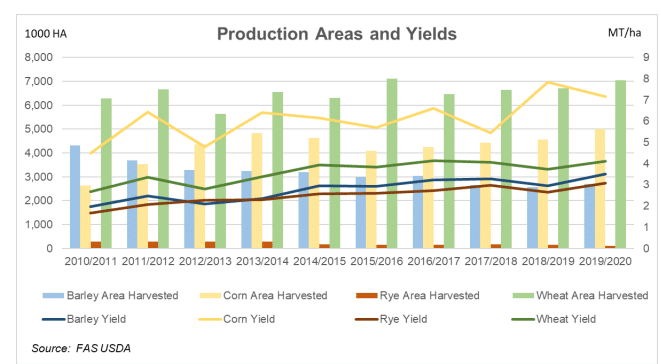
Source: USDA, Foreign Agricultural Service, annual report April 2020.
By the way, despite the closure of ports through which Ukraine shipped 5-5.5 million tons of grain every month, the exports did not stop. According to the statistics, in March-April the Ukraine was able to send 2.7 million tons of grain to the foreign market (mainly through Moldova and Romania). But there was no trade destination to compensate for more than 8 million tons of supplies which have dropped out of trade during this period.
Not only Ukraine
Now let’s add a few more factors here. Grain exports from Russia in the current marketing year (July 1, 2021–March 10, 2022) amounted to 28.1 million tons, which is 30% lower than last year’s figure. Since mid-March the export of grain and sugar from the Russian Federation has been limited until June 30 (allowed only under licenses within the quota). In general, since the beginning of the special military operation, 20 countries of the world have imposed certain restrictions on food exports. Another one could be India, where a ban on wheat exports is being discussed. Despite the fact that back in mid-March India intended to take advantage of the situation and draw customers from Russia and Ukraine.
This Kommersant publication notes that individual importers are also increasing the panic on the world grain market. Some of them directly refuse to cooperate with Russian suppliers; others are experiencing difficulties due to sanctions. As a result, everyone is looking for an alternative but that does not exist in the current conditions–and this thereby additionally accelerates prices.
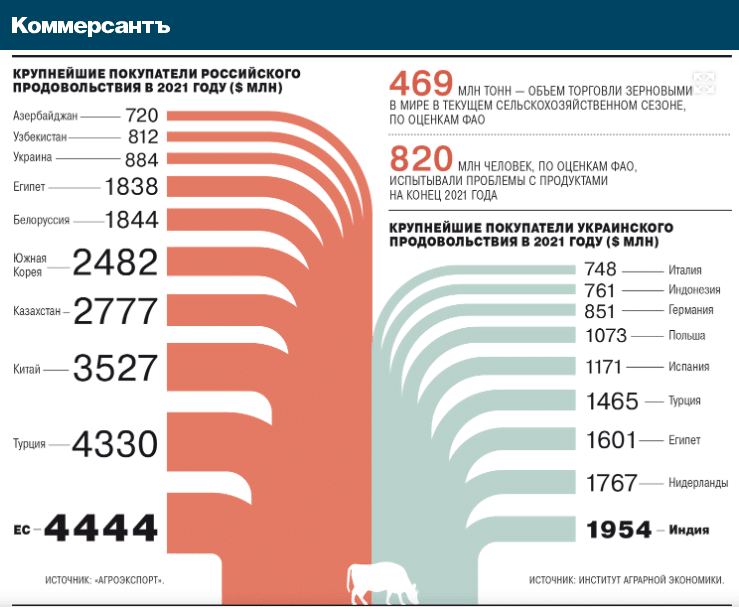
KEY: left red= the major country importers of Russian food products in $ million in 2021; right grey=the Ukraine. 469=supply in million tons of grain to the world market (FAO estimate); 820=million people short of their food requirement (FAO estimate). Source: https://www.kommersant.ru/
Finally, let’s not forget about the increase in the cost of grain production at all stages. The increase in the cost of fuel–from the farm tractor and combine harvester to the grain bulk carrier at sea–together with the jump in fertilizer prices due to the several-magnitude increase in the price of natural gas for fertilizer production.
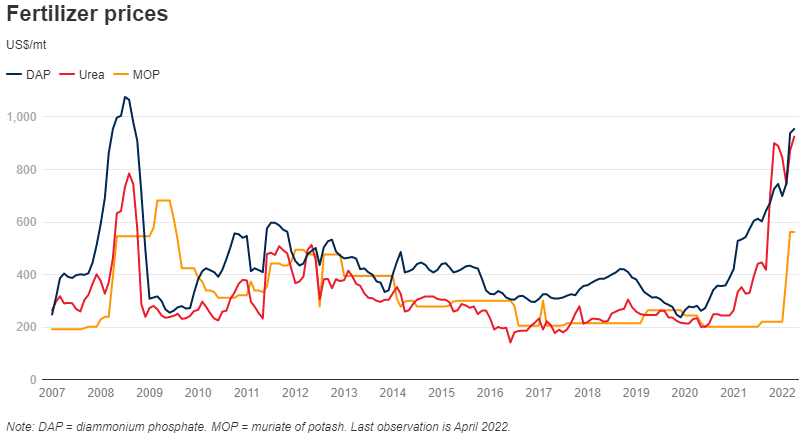
Source: https://blogs.worldbank.org/
So to sum up: Putin as the cause of food inflation in the United States and the world–for the purpose of official state declarations, of course this is good enough. But in fact, the root cause of this crisis was the United States itself: its sanctions, its desire to reduce Russia’s export earnings from the energy trade. And all this began long before the start of the hot events in Ukraine. Take the well-known Nord Stream–2: if its launch had not been torpedoed with the active participation of the United States, gas prices in Europe and the world today would be lower, and fertilizers would be cheaper.
They would be even cheaper if Russian ships could transport these fertilizers without facing a ban on entering EU ports. Not to mention the fact that the special military operation might not have happened if the Biden administration had not pumped Ukraine with weapons and political support.
According to Biden and his administration, the key to reducing food inflation is stored in 20 million tons of Ukrainian grain. That’s not so. The key is to realize a simple fact: the global economy does not work well with sanctions and the cutoff of individual countries from this economy.

